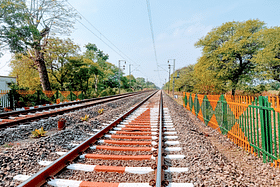Stepping up electrification drive, Indian Railways has electrified a total of 59,524 kilometre-length of broad gauge rail line as on 1 August this year, Lok Sabha was told.
Electrification offers various benefits, including reduced operating cost and reduced dependence on imported crude oil thereby saving precious foreign currency.
Haulage of heavier freight trains and longer passenger trains due to higher haulage capacity of electric locomotives, leading to increased throughput and increased sectional capacity by eliminating detention on account of traction change are other benefits.
Besides, electrification is also an environment-friendly mode of transport.
The completion of electrification depends on various factors like forest clearances by officials of forest department, shifting of infringing utilities, statutory clearances from various authorities, geological and topographical conditions of area, law and order situation in the area of project site, number of working months in a year for particular project site due to climatic conditions etc.
Speeding up of trains is a constant endeavour and a continuous process by the Indian Railways.
One of the objectives of rationalisation of time table, undertaken by the Railways in a scientific manner with the assistance of IIT-Bombay, has been speeding up trains services by converting passenger trains to express services and express services to superfast services.
Conversion of trains operating with conventional coaches to MEMUs, is also aimed at providing faster services to the passengers.
Further, Indian Railways is introducing Vande Bharat trains, which have higher speed potential. Till 3 August, 2023, 50 Vande Bharat services have been introduced on the Railways network.
Several steps been taken to increase the speed of the trains such as raising the sectional speed to 130 kmph, over 10,400 route km covering the golden quadrilateral and diagonal routes and other important routes of rail network.
Work for raising of sectional speed to 160 kmph on existing New Delhi-Mumbai (including Vadodara-Ahmedabad) and New Delhi-Howrah (including Kanpur-Lucknow) routes have been sanctioned at a cost of Rs 6,806 crore and Rs 6,685 crore, respectively.
Indian Railways continuously intends to modernise the existing signaling system by providing electrical/electronic interlocking system with centralised operation of points and signals, in place of the old mechanical signaling.
These systems have been provided at 6,443 stations as on 30 June 2023.
Complete track-circuiting of stations to enhance safety, for verification of track occupancy by electrical means, has also been provided at 6,381 stations.
Interlocking of level crossing gates has been provided at 11,102 locations as on 30 June 2023, for enhancing safety at the level crossing.


